
Two frogs are in a tank. One frog turns to the other and says… “Do you know how to drive this thing?!”
Table of Contents hide
Ok, silly jokes aside(!), if you’re going to keep frogs at home, you’re going to need a frog tank of some kind. After all, you can’t just have frogs hopping freely around your house!
But how do you set up a frog tank to ensure your pet frogs stay healthy and happy? Read on to find out…
What do frogs need to survive?
Let’s start by thinking about what frogs need from their tank in order to survive. What do you need to think about when creating a frog habitat? The main things are:
- Humidity: This means the amount of water that is in the air.
- Temperature: The inside of your frog tank may need to be hotter than the rest of your house.
- Lighting: Wild frogs spend time out in the sunlight, whereas pet frogs generally don’t. You’ll therefore need to artificially provide the light they need.
- Tank type and size: Like all animals, frogs need enough space to live happily.
- Plants: Frogs enjoy having plants in their tank, as they provide places to hide.
- Water: Very important to all amphibians, water lets your frog take a dip and adds to the humidity in the tank.
But how do you set up a frog tank that satisfies all the conditions needed for your frog to survive? And how do frog habitats vary by species?
How to set up a frog tank
We’ve listed the main things that frogs need from their tank to survive. Now let’s take a closer look at each of these important parts of a frog’s habitat.
Humidity in a frog tank
The humidity in a tank is essential to all species of frogs. Without the right humidity, your frog won’t shed properly, and this can lead to various severe health conditions as you can read here (why do frogs shed?). Humidity tends to impact amphibians, such as your frog, more severely.
If you don’t provide the proper humidity, your frog will just dry up. It doesn’t matter where your frog comes from. If it is a tropical rainforest or the harshest desert. Humidity is necessary to it’s well being.
What is the best humidity for frogs?
This depends on the species of your frog. If you want to hold frogs as pets, make sure that you provide the right conditions so that your frog can survive in a tank.
Below is a chart where you can see which frog needs which percentage of humidity and ways to maintain it.
| Frogs | Humidity % | How to maintain |
|---|---|---|
| Golden Tree Frog | Over 60% | Misting the tank about once or twice a day. On dry months only. Also, provide a water bowl. |
| Green Tree Frog | Over 65% | Misting your tank several times a week. Only during dry months. Also, provide a water bowl. |
| Leopard Frog | 70% – 75% | Only mist the tank in the evening. Use a moisture-retaining substrate and, use a large water bowl. |
| Ornate Horned Frog | 50% – 70% | Use a moisture-retaining substrate, mist the tank daily and provide a water bowl. |
| Red-eyed Tree Frog | 60% – 70% | Have a terrarium cover, use a moisture-retaining substrate and mist the tank. |
| White’s Tree Frog | 50% – 60% | Mist the tank of your White’s Tree Frog daily and provide a water bowl. |
| Pacman Frog | 60% – 80% | Use appropriate live plants, mist lightly, use a moisture-retaining substrate and provide a water bowl |
Frog tank temperature
We humans are what we call warm-blooded. Our body measures the local temperature, and we then shives or sweat appropriately to maintain a body temperature of about 37 degrees Celcius. This is not the case when we look at frogs.
Frogs are what we call cold-blooded. They don’t maintain the right temperature by shivering or sweating, but they maintain the temperature of the immediate environment. The right temperature is relative to the species of the frog.
Below I have made a chart where you can see which frog needs which temperature.
| Frogs | Temperature F |
|---|---|
| Golden Tree Frog | Do best when kept in the mid-high 70s (around 74 to 76F) |
| Green Tree Frog | Need a day temperature between 74 and 82F. Night temperature can be between 64 and 72F. |
| Leopard Frog | Can be held at room temperature between 58 and 75F. At night you can drop the temperature down to 60F. |
| Ornate Horned Frog | Do best when kept between 65 and 85F most of the time. At night the temperature can be reduced. |
| Red-eyed Tree Frog | Need a day temperature between 75 and 85F At night the temperature can be between 65 and 75F. |
| White’s Tree Frog | Do best when kept between 75 and 85F Personally I think between 74 and 76F is best. |
| Pacman Frog | Need a day temperature between 75 and 85F. During the night it can be between 65 and 75F. |
How to provide the right temperature
You can provide the right temperature for your frog to make use of a heat lamp or an under-tank heater to warm the terrarium. To help you keep track of the temperature you can use a thermometer in the habitat.
Adding light to your frog tank
Do frogs need sunlight?
Light is of vital importance for keeping your frog healthy. In nature, frogs have evolved to use the sunlight to their advantage as a source of heat and UVB radiation. Both of these sources help with some metabolic processes. When your frog is in captivity, you need to mimic this kind of conditions so that your frog can live healthily. In a tank, lighting is primarily used for three things: heat, UVB radiation and as lighting for the vivarium.
For heat: As you now know, frogs are cold-blooded which means that they depend on their environment for their temperature. An area of elevated temperature in your vivarium gives the frog the opportunity to raise its body temperature.
For UVB Radiation: The sun is not only a source of heat, but it also gives an intense source of ultraviolet radiation. Exposing your frog to the UVB radiation, even for a short amount of time, provides the Vitamin D production it needs for proper calcium absorption in the intestines. When your frog is in a tank, UVB lighting is generally given by artificial means.
For the benefit of plants: Lighting in the vivarium usually is only necessary to keep the plants in the habitat happy.
Types of frog tank
Creating a proper tank environment requires a bit of thought. It entirely depends on the natural habitat of your frog. There are four standard tank setups for frog care that you can consider.
Terrestrial tanks
This type of container is best suited for a dry climate. It is a large tank with a substrate, a water bowl, plants, and branches for the frog.
Aquatic tanks
As the name already reveals, this tank is full of water and is mainly the same setup as you would have for fish. It primarily consists of a substrate of aquarium gravel and some plants as for decor.
Half & half tanks
This is probably the most common setup. This setup consists of half water and half land. You can do
Arboreal tanks
This tank is almost specially made for Treefrogs. Most of the time they spend their time high in tree branches. This is why tree frogs are better off in a taller tank that suits their instincts. You can use a square of hexagon shape tank with lots of branches so that your tree frog can climb.
What size tank do frogs need?
The size of the tank depends on the species of the frog. Smaller frogs can live in smaller tanks but as the frog grows, so does the tank size. A general rule is that most species do well in a 20-gallon tank.
Water in a frog tank
Water is very important to frogs. At the very least, your frog tank will include a bowl of water, and some types – aquatic tanks and half & half tanks – have much more water of course.
When including water in your frog tank, it’s important that you look after the condition of the water. You’ll need to add a filter to break down waste or else the water will quickly become polluted.
Water filtration
Filtration plays a vital part in any aquatic or half/half tank. Water filters clean the water in mainly three ways: Mechanical, biological and chemical.
Mechanical filtration physically removes debris from the water
Biological filtration uses bacteria and something called beneficial strains to break down all the organic waste in the tank.
Chemical filtration binds impurities and organic residues chemically and then remove it from the system.
Regardless of which filtration system is in place, it is essential to maintain a high quality of water and change your tank water regularly.

Hi, I’m Mike, and I’m the creator of amphibianlife.com. If there was one word to describe it? It would be: passionate about Amphibians! Whether you want to know more about amphibians or have a presentation to give at school, you’ve come to the right place.
